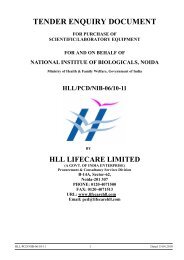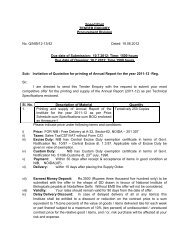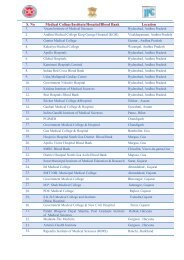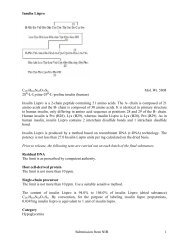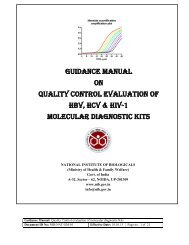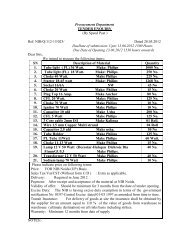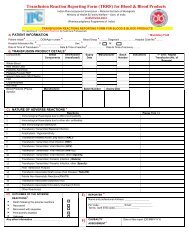Insulin Aspart Injection
Box 2
Box 2
- No tags were found...
Create successful ePaper yourself
Turn your PDF publications into a flip-book with our unique Google optimized e-Paper software.
<strong>Insulin</strong> <strong>Aspart</strong> <strong>Injection</strong><br />
Definition<br />
<strong>Insulin</strong> <strong>Aspart</strong> injection is a sterile, neutral, aqueous solution of <strong>Insulin</strong> <strong>Aspart</strong>.<br />
The injection complies with the requirements stated under <strong>Insulin</strong> Preparations with the<br />
modifications described below.<br />
Content of <strong>Insulin</strong> <strong>Aspart</strong><br />
Not less than 90% and not more than 110 % of the stated amount on the label.<br />
Description<br />
A colorless liquid, free from turbidity and foreign matter; during storage traces of a very fine<br />
sediment may be deposited.<br />
Identification<br />
In the Assay, principal peak in the chromatogram of the test solution corresponds to that in the<br />
chromatogram of the reference solution.<br />
Tests<br />
pH (2.4.24)<br />
Between 6.9 to 7.8<br />
Related proteins<br />
Determine by Liquid Chromatography 2.4.14 as described under assay: use the normalization<br />
procedure.<br />
Limits:<br />
• B28isoAsp insulin aspart: not more than 2.5% is found<br />
• Total of B3Asp insulin aspart, A21Asp insulin aspart and B3isoAsp insulin aspart: not more<br />
than 5.0%<br />
• Total of other impurities: not more than 3.5%<br />
Total Zinc<br />
Between 10 and 40 µg per 100 units of <strong>Insulin</strong> <strong>Aspart</strong><br />
Atomic Absorption Spectrometry<br />
Test solution: Shake the preparation gently and dilute a volume containing 100 units of insulin<br />
aspart to 25.0 ml with 0.01M hydrochloric acid. Dilute, if necessary, to a suitable concentration<br />
of zinc (for example 0.1 μg to 1.0 μg of Zn per milliliter) with 0.01M hydrochloric acid.<br />
Reference solutions: Use solutions containing a suitable range of concentrations, for example<br />
0.20 μg, 0.40 μg, 0.60 μg, 0.80 μg and 1.00 μg of Zn per milliliter, freshly prepared by diluting<br />
zinc standard solution (5 mg/ml Zn) with 0.01M hydrochloric acid.<br />
Measure the absorbance at 213.9 nm using a zinc hollow-cathode lamp as source of radiation and<br />
an air-acetylene flame of suitable composition (for example 11 liters of air and 2 liters of<br />
acetylene per minute).<br />
Submission from NIB 1
Bacterial endotoxins (2.2.3)<br />
It contains less than 80 Units per 100 units of <strong>Insulin</strong> <strong>Aspart</strong>.<br />
Impurities with molecular masses greater than that of <strong>Insulin</strong> <strong>Aspart</strong><br />
Determine by size exclusion chromatography 2.4.16: use the normalization procedure.<br />
Test solution: Add 4 µl of 6 M hydrochloric acid per ml of the preparation under examination,<br />
whether a suspension or a solution, to obtain a clear acid insulin solution. When sampling a<br />
suspension, agitate the material prior to sampling in order to obtain a homogenous sample. If a<br />
suspension does not turn clear within 5 min. of the initial addition of hydrochloric acid, add<br />
small aliquots of the acid (less than 4 µl/ ml) until a solution is obtained.<br />
Mobile phase, Resolution solution and chromatographic system are as directed in the Impurities<br />
with molecular masses greater than that of <strong>Insulin</strong> <strong>Aspart</strong>.<br />
Limits: the sum of the areas of the peaks with a retention time less than that of the principal peak<br />
is not more than 3.0% (protamine containing preparations) or 2.0% (non- protamine containing<br />
preparations) of the total areas of the peaks. Disregard any peak with a retention time greater<br />
than that of the peak due to insulin aspart monomer.<br />
Assay<br />
Determine by Liquid Chromatography (2.4.14)<br />
Test solution: acidify each ml of the preparation being examined with 4 µl of 6 M hydrochloric<br />
acid. Dilute, if necessary, a portion of the acidified solution with 0.01 M hydrochloric acid to<br />
obtain a solution containing about 100 insulin aspart units per ml. Maintain the solution at 2-8°C.<br />
Reference solution: Dissolve the contents of a vial of insulin aspart RS in 0.01 M hydrochloric<br />
acid to obtain a known concentration of 100 insulin aspart units per ml. Add 4 µl of 6 M<br />
hydrochloric acid per ml and mix. Maintain the solution at 2-8°C.<br />
Resolution solution: Use an appropriate solution with a content of B3Asp insulin aspart and<br />
A21Asp insulin aspart of not less than 1 per cent. This may be achieved by storing reference<br />
solution at room temperature for about 1-3 days.<br />
Column: Stainless steel column, 25 cm x 4.0mm that contains octadecyl silyl silica gel for<br />
chromatography, 5 µm<br />
Mobile phase A: dissolve 70.0 g of anhydrous sodium sulphate in approximately 4500 ml of<br />
water; add 6.5 ml of phosphoric acid and adjust to pH 3.4 with sodium hydroxide. Dilute to 5000<br />
ml with water. Mix 900 ml of this solution with 100 ml of acetonitrile.<br />
Mobile phase B: mix equal volumes of water and acetonitrile.<br />
The chromatogram is programmed as follows:<br />
Time (min) Mobile phase A (%) Mobile phase B (%) Comments<br />
0 - 35 58 42 Isocratic<br />
35 - 40 58 20 42 80 Linear gradient<br />
40 - 45 20 80 Isocratic<br />
45 - 46 20 58 80 42 Linear gradient<br />
46 - 60 58 42 Re-equilibration<br />
Submission from NIB 2
Adjust the mobile phase composition and the duration of the isocratic elution to obtain a<br />
retention time of about 22 min for insulin aspart and to ensure that B3isoAsp insulin aspart is<br />
eluted before the gradient starts.<br />
Column temperature: 35°C<br />
Flow rate: 1 ml/min.<br />
Detection wavelength: 214 nm.<br />
<strong>Injection</strong> volume: 10 µl.<br />
When the chromatograms are recorded under the prescribed conditions the relative retention<br />
times with reference to insulin aspart (retention time, 20 to 26 min): B28isoAsp insulin aspart =<br />
approximately 0.9; B3Asp insulin aspart and A21Asp insulin aspart (generally coeluted) =<br />
approximately 1.3; B3isoAsp insulin aspart = approximately 1.5.<br />
Procedure: separately inject the reference solution, the test solution and the resolution solution<br />
into the chromatograph, record the chromatograms and measure the peak areas.<br />
System suitability:<br />
The test is not valid unless, in the chromatogram obtained with Resolution Solution, the<br />
resolution between the peak due insulin aspart and the peak due to B3Asp insulin aspart and<br />
A21Asp insulin aspart is greater than 1.6.<br />
The test is not valid unless, the symmetry factor of the principal peak in the chromatogram<br />
obtained with Reference Solution is not more than 1.8<br />
The relative standard deviation of the insulin aspart peak area in the chromatograms obtained<br />
with five replicate injections of the Reference Solution is not more than 1.4%.<br />
Calculate the content of insulin aspart together with B28isoAsp insulin aspart, A21Asp insulin<br />
aspart, B3Asp insulin aspart and B3isoAsp insulin aspart using the areas of the corresponding<br />
peaks in the chromatograms obtained with Test Solution and Reference Solution and the<br />
declared content of insulin aspart together with B28isoAsp insulin aspart, A21Asp insulin aspart,<br />
B3Asp insulin aspart and B3isoAsp insulin aspart in insulin aspart RS<br />
Storage<br />
Preserve in the unopened, multi-dose container provided by the manufacturer. Store in a<br />
refrigerator (5+3˚C), protect from sunlight and avoid freezing.<br />
Labelling<br />
The label states that (1) the strength in terms of insulin aspart units per ml; (2) the material is<br />
produced by microbial synthesis via recombinant DNA technology; (3) the storage conditions.<br />
Submission from NIB 3
Biphasic <strong>Insulin</strong> <strong>Aspart</strong> injection<br />
Biphasic <strong>Insulin</strong> <strong>Aspart</strong> <strong>Injection</strong> complies with the monograph of <strong>Insulin</strong> <strong>Aspart</strong> <strong>Injection</strong><br />
monograph with the amendments prescribed below:<br />
Description<br />
A White suspension<br />
Test for % <strong>Insulin</strong> aspart in solution in Biphasic <strong>Insulin</strong> aspart (30/70) samples:<br />
Biphasic insulin aspart products are mixtures of insulin aspart in solution and crystalline<br />
protamine insulin aspart. The content of insulin aspart in solution (after addition of Tris/EDTAbuffer)<br />
relatively to the total content of insulin aspart is determined by GPC- HPLC.<br />
Column:<br />
- size l=0.3 m, Ø= 7.8 mm,<br />
- stationary phase: hydrophilic silica gel for chromatography R (5-10 μm) with a pore size of<br />
12-12.5 nm,<br />
Method a)<br />
Mobile phase: 2.5 M acetic acid.<br />
Column temperature: ambient<br />
Flow rate: 2.0 ml/min.<br />
Detection wavelength: 280 nm.<br />
<strong>Injection</strong>: 50 μl.<br />
Run time: About 10 min<br />
Method b)<br />
Mobile phase: Mix 15 volumes of glacial acetic acid R, 20 volumes of acetonitrile for<br />
chromatography R and 65 volumes of a 1.0 g/l solution of arginine R; filter and degas.<br />
Column temperature: ambient<br />
Flow rate: 0.5 ml/min.<br />
Detection wavelength: 276 nm.<br />
<strong>Injection</strong>: 100μl.<br />
Run time: About 35 min<br />
Equilibration: At least 3 injections of the resolution solution; the column is equilibrated when<br />
repeatable results are obtained from 2 subsequent injections.<br />
Resolution solution: Use a solution of insulin (about 4 mg/ml), containing more than 0.4 per cent<br />
of high molecular mass proteins. An injectable insulin preparation, whether a solution or a<br />
suspension, that has been clarified with a sufficient amount of 6M hydrochloric acid R,<br />
containing the indicated percentage of high molecular mass proteins, or a solution prepared from<br />
insulin, dissolved in 0.01M hydrochloric acid may be used. <strong>Insulin</strong> containing the indicated<br />
percentage of high molecular mass proteins may be prepared by allowing insulin powder to stand<br />
at room temperature for about 10 days. Maintain the solution at 2-8°C and use within 7 days.<br />
Sample Preparation<br />
Tris/EDTA buffer (approx. pH 8.6): dissolve 6.05g of Tris and 4.50g of EDTA in approx. 80ml<br />
of water in a 100ml volumetric flask. Add 1.80ml 4M HCl and add water to volume. Do not<br />
adjust pH.<br />
Submission from NIB 4
<strong>Insulin</strong> aspart in solution (ins.asp.sol.): The whole content of a sample is transferred to a<br />
centrifuge tube. Add 25µl Tris/EDTA-buffer per 1.5ml of sample and mix for 5 seconds by<br />
means of a tube shaker.<br />
The tube (plugged) is placed at 25°C for 1 hour. Centrifuge for 10min at 3000 rpm at 21- 25°C.<br />
Decant the clear supernatant. Centrifuge this supernatant for 10min at 3000 rpm at 21- 25°C.<br />
Decant the clear supernatant.<br />
Add 4µl of 6M HCl per ml of the clear supernatant and mix thoroughly.<br />
Total insulin aspart (ins.asp.tot.): Add 4µl of 6N HCl per ml of sample and mix thoroughly.<br />
Determination of <strong>Insulin</strong> aspart in solution (ins.asp.sol.) as well as of Total insulin aspart<br />
(ins.asp.tot.): the acidified sample solutions are subject to GPC-HPLC.<br />
System suitability:<br />
Method a)<br />
The number of theoretical plates, N (5 sigma) calculated from the insulin aspart monomer peak<br />
in the chromatogram obtained with the total insulin aspart solution is not less than 1000.<br />
t<br />
R<br />
N = 25 ( )<br />
W<br />
t R is the retention time (approx. 5 minutes)<br />
W is the peak width at 4.4 % of peak height<br />
Method b)<br />
Resolution solution: peak-to-valley ratio: minimum 2.0, where H p = height above the baseline of<br />
the peak due to the dimmer and H v = height above the baseline of the lowest point of the curve<br />
separating this peak from the peak due to the monomer.<br />
Calculation for potency in solution<br />
The relative content of insulin aspart in solution is calculated by means of the insulin aspart<br />
monomer peak areas in the chromatograms obtained with the solution ‘insulin aspart in solution’,<br />
A ins.asp.sol. , and with the solution ‘total insulin aspart’, A ins.asp.tot :<br />
% insulin aspart in solution= A ins.asp.sol . 1525 . 100%<br />
A ins.asp.tot . 1500<br />
The concentration of <strong>Insulin</strong> aspart in solution is in the range of 24.2-36.0% for 30/70 Biphasic<br />
<strong>Insulin</strong> <strong>Aspart</strong> <strong>Injection</strong><br />
Submission from NIB 5



